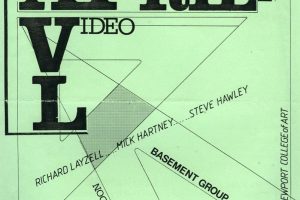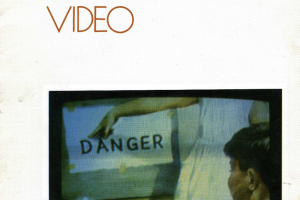Bourn, Ian
“Born in London 1953. Studied at Ealing School of Art, 1972-75; Royal College of Art, London, 1976-79.
Screenings include Bracknell Video Festival; Hayward Gallery, London; The Kitchen, New York; Stedelijk Museum, Amsterdam; National Film Theatre, London; Image Forum, Tokyo.
Video Fellowship (awarded by Arts Council of Great Britain and Sheffield City Polytechnic), 1982-83.
Co-instigator with Chris White of HOUSEWATCH (est. 1985): a group of mixed-media artists who collaborate, individually or collectively, to produce environmental site-specific performance events – initial project ‘Cinematic Architecture for the Pedestrian'” Luxonline, 2005.
“Ian Bourn has been making videos since the late 70s, at a time when most video artists were experimenting with black and white low-band U-matic, and relatively few homes had video recorders.
However it was the medium’s means of playback – on domestic-TV-like monitors – which attracted Bourn, who saw the potential for using the familiarity of television’s modes of address to develop his own highly personal and idiosyncratic style. Taking his cue less from contemporary artists’ film and more from televisual conventions, with a particular antipathy for TV’s portrayal of the ‘cheeky Cockney chappie’, he set out to develop his own pantheon of imaginary tragi-comic characters, pitched somewhere between Tony Hancock and Harold Pinter.
Bourn has described his single-screen video work as ‘a kind of portraiture that examines role-play and the viewer’s relationship with people portrayed on film.’ As well as being a consummate writer, Bourn is also an actor, often appearing in his own and other’s work. The blurring of fiction and autobiography is what gives the work its edge. This is paralleled in his work for ‘Housewatch’, a mixed-media group co-founded by Bourn in 1985, in which the facades of real houses are used, their illuminated windows presenting the passer-by with an illusory, fictional interior.”
Felicity Sparrow, Luxonline, 2005.
-
-
Videography:
Video tapes
1978
Wedding Speech
Lenny’s Documentary1979
From The Junkyard
Mayday
B.29 Three Nights In1982
The End of The World1983
The Last Lark1987
Tips for Travelling Salesman1989
Sick As A Dog1991
Out Of It1992
Breathing Days1998
Monolog1999
The Kiss (with John Smith)2000
Alfred Hitchcock 20002001
Owner Occupier
(untitled)2003
Black, White & Green – the way of pie2005
SecurityVideo Installation / Housewatch
1990
Deceleration / Desire (2 screen)1992
Contra-Flow
Broadgate Arena, Liverpool Street, London
Little Big Horn
The Undercroft, Southbank Centre, London
Paperhouse
Xebec Hall, Kobe, Prefectoral Museum, Kyoto and Art Tower, Mito, Japan
Imaginary Opera
Prefectoral Museum, Kyoto, Royal Festival Hall, London1994
Fallow Field (16 screen)1997
Conservatory
LUX Centre, LondonVideo Performance
2003
Slow Life
Matts Gallery, London2006
Wake Up / Hide
Matts Gallery, London -
Artist works:
-
Artist assets:
-
Quotes:
"Another story-teller who began to make an impact in the early 1980s was Ian Bourn (b.1953), who converted the familiar monologue-to-camera of early video into a wholly fictional form with none of the video-specific allusions of his predecessors. Beginning with Wedding Speech (1978), ostensibly a tape recorded by an absent best-man, he created a series of fictional selves, witty and sometimes sad portraits of East End characters: the obsessive model-plane maker in B29 (Three Nights In) (1979); two half-vacant minds - a video-game addict (the artist) and his sunbathing partner (Helen Chadwick) in The End of The World (1982); a failed punter trying to sell on his gambling 'method' in Sick as a Dog (1989), this last simultaneously an affectionate portrait of the declining London sport of greyhound racing, and a parody of instructional videos. His humour and deadpan delivery led to his involvement as a writer-performer in films by John Smith and Paul Bush."
David Curtis, A History of Artists' Film and Video in Britain. British Film Institute, 2007.





